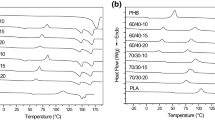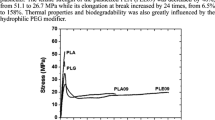Abstract
The medleys of the plastic-derived polypeptide with commercially available polymers believably the suitable candidate for pharmaceutical and biomedical importance. The current research is focussed on the synthesis of a novel plastic-mimetic polypeptide (PLP), poly(IPAVG) by the solution phase method (where I, P, A, V, and G represent Isoleucine, Proline, Alanine, Valine, and Glycine, respectively). The miscibility attributes of PLP/polyvinyl alcohol (PVA) and PLP/hydroxypropylmethylcellulose (HPMC) blends were examined by viscometry and by other advanced analytical tools for different weight proportions. It is shown by the viscometry that the PLP/HPMC and PLP/PVA form an immiscible blend system at 10 οC and further, the FTIR spectra of poly (IPAVG) /HPMC and poly (IPAVG) /PVA blend membranes manifest the lack of intermolecular interactions. DSC results proved the dual Tg for one blend proportion and lower Tg values for all other blend systems. The thermal property of the blends with different compositions was evaluated by thermogravimetric analysis (TGA). The TGA results showed that the blends possess inferior thermal stability to the native ones. The surface morphology was analyzed by SEM indicated the heterogeneity and X-ray diffraction (XRD) revealed the absence of any change in crystallinity advocated the immiscibility of the blends. Further, we ventured to prepare the non-woven fabrics from the solutions of 1–10 wt% concentrations at the voltages within 20–30 kV by electrospinning. The droplet formed at the spinneret failed to reach the collector plate, and consequently, no films developed for the collector device.

Graphical abstract













Similar content being viewed by others
References
Urry DW (1997) Physical chemistry of biological free energy transduction as demonstrated by elastic protein-based polymers†. J Phys Chem B 101:11007–11028
Meyer DE, Chilkoti A (2002) Genetically encoded synthesis of protein-based polymers with precisely specified molecular weight and sequence by recursive directional ligation: examples from the elastin-like polypeptide system. Biomacromolecules 3:357–367
Urry DW, Pattanaik A, Jie X, Woods CT, McPherson DT, Parker TM (1998) Elastic protein-based polymers in soft tissue augmentation and generation. J Biomater Sci Polym Ed 9:1015–1048
Frandsen JL, Ghandehari H (2012) Recombinant protein-based polymers for advanced drug delivery. Chem Soc Rev 41:2696–2706
Urry DW, Luan CH, Peng SO, Parker TM, Gowda DC (1991) MRS proceedings 255–411
Wright ER, Conticello VP (2002) Self-assembly of block copolymers derived from elastin-mimetic polypeptide sequences. Adv Drug Del Rev 54:1057–1073
Qi X, Jiang Y, Li X, Zhang Z, Wu Z (2015) J Appl Polym Sci 132:42059
Barik A, Patnaik T, Parhi P, Swain SK, Dey RK (2017) Polym Bull 74:3467–3485
Arik N, Inan A, Demirci EAIF, Karaman O, Ercan UK, Horzum N (2019) Modification of electrospun PVA/PAA scaffolds by cold atmospheric plasma: alignment, antibacterial activity, and biocompatibility. Polym Bull 76:797–812
Kim J, Lee CM (2017) Wound healing potential of a polyvinyl alcohol-blended pectin hydrogel containing Hippophae rahmnoides L. extract in a rat model. Int J Biolog Macromol 99:586–593
Sionkowska A (2011) Current research on the blends of natural and synthetic polymers as new biomaterials: review. Prog Polym Sci 36:1254–1276
Lewandowska K (2005) The miscibility of poly(vinyl alcohol)/poly(N-vinylpyrrolidone) blends investigated in dilute solutions and solids. Eur Polym J 41:55–64
Patel M (2004) Viscoelastic properties of polystyrene using dynamic rheometry. Polym Test 23:107–112
Cabanelas JC, Serrano B, Baselga J (2005) Development of cocontinuous morphologies in initially heterogeneous thermosets blended with poly(methyl methacrylate). Macromolecules 38:961–970
Nanjundaswamy GS, Mahesh B, Channe Gowda D (2018) Polym Int 67:1511–1522
Wanchoo RK, Sharma PK (2003) Viscometric study on the compatibility of some water-soluble polymer–polymer mixtures. Eur Polym J 39:1481–1490
Freitas AR, Gaffo L, Rubira AF, Muniz EC (2014) Miscibility studies on polychloroprene/natural rubber (PCP/NR) blends by dilute solution viscometry (DSV) and scanning electronic microscopy (SEM) methods. J Mol Liq 190:146–150
Guo Q, Luo P, Luo Y, Du F, Lu W, Liu S, Yu J (2012) Fabrication of biodegradable micelles with sheddable poly(ethylene glycol) shells as the carrier of 7-ethyl-10-hydroxy-camptothecin. Colloids Surfaces B: Biointerfaces 100:138–145
Zhu GQ, Li GC, Wang P (2011) Surface morphology and properties of poly(γ-benzylL-glutamate)/poly(butyl acrylate-co-methyl methacrylate) blend film. Polym Plast Tech Eng 50:1470–1474
Zhu G, Gao Q, Wang F, Zhang H (2011) Structure and performance of poly(vinyl alcohol)/poly(γ-benzylL-glutamate) blend membranes. Int J Polym Mater 60:720–728
Kuo SW, Chen CJ (2011) Using hydrogen-bonding interactions to control the peptide secondary structures and miscibility behavior of poly(l-glutamate)s with phenolic resin. Macromolecules 44:7315–7326
Kuo SW, Chen CJ (2012) Functional polystyrene derivatives influence the miscibility and helical peptide secondary structures of poly(γ-benzyll-glutamate). Macromolecules 45:2442–2452
Lu YS, Lin YC, Kuo SW (2012) Macromolecules 45:6547–6556
Murata K, Kono H, Katoh E, Kuroki S, Ando I (2003) Polym 44:4021–4027
Mahesh B, Kathyayani D, Nanjundaswamy GS, Channe Gowda D, Sridhar R (2019) Carbohydr Polym 212:129–141
Baba AR, Gowda DC, Kadimi US (2005) Ind J chem Sec B 44:1487
Huggins ML (1942) The viscosity of dilute solutions of long-chain molecules. IV Dependence on Concentration J Am Chem Soc 64:2716–2718
Masuelli MA (2011) Int J Biolog Macromol 48:286–291
Chee KK (1990) Determination of polymer-polymer miscibility by viscometry. Eur Polym J 26:423–426
Jiang WH, Han SJ (1998) An improved criterion of polymer–polymer miscibility determined by viscometry. Eur Polym J 34:1579–1584
Sun Z, Wang W, Feng Z (1992) Criterion of polymer-polymer miscibility determined by viscometry. Eur Polym J 28:1259–1261
Garcia R, Melad O, Gómez CM, Figueruelo JE, Campos A (1999) Eur Polym J 35:47–55
Shetty GR, Rao BL, Asha S, Wang Y, Sangappa Y (2015) Preparation and characterization of silk fibroin/hydroxypropyl methyl cellulose (HPMC) blend films. Fibers Polym 16:1734–1741
Lewandowska K, Sionkowska A, Grabska S, Kaczmarek B, Michalska M (2016) The miscibility of collagen/hyaluronic acid/chitosan blends investigated in dilute solutions and solids. J Mol Liq 220:726–730
Radhakrishnan Nair MN, Biju PK, Thomas GV, Gopinathan Nair MR (2009) Blends of PVC and epoxidized liquid natural rubber: studies on impact modification. J Appl Polym Sci 111:48–56
Wang C, Hu Z, Q’a Y, Liu X, Liu Q, Bao C (2020) J Polym Research:27–148
Thomas S, Grohens Y, Jyotishkumar P (2014) (Eds) Wiley-VCH Verlag Weinheim Germany 978–3–527-33153-6
Fox TG, Flory PJ (1950) Second-order transition temperatures and related properties of polystyrene. I. Influence of molecular weight. J Appl Phys 21:581–591
Wood LA (1958) Glass transition temperatures of copolymers. J Polym Sci 28:319–330
Kannan M, Bhagawan SS, Thomas S, Joseph K (2013) Thermogravimetric analysis and differential scanning calorimetric studies on nanoclay-filled TPU/PP blends. J Therm Anal Calorim 112:1231–1244
Zhou P, Zou L, Zha S, Yang A, Jiang S, Guan R (2020) Compatibility and thermal decomposition behavior of acrylic block copolymer modified epoxy resin. J Polym Res 27:4
Dandurand J, Samouillan V, Lacoste-Ferre MH, Lacabanne C, Bochicchio B, Pepe A (2014) Conformational and thermal characterization of a synthetic peptidic fragment inspired from human tropoelastin: signature of the amyloid fibers. Pathol Biol 62(2):100–107
Nair RM, Bindhu B, Reena VL (2020) A polymer blend from gum Arabic and sodium alginate - preparation and characterization. J Polym Res. https://doi.org/10.1007/s10965-020-02128-y
Gaabour LH (2017) Spectroscopic and thermal analysis of polyacrylamide/chitosan (PAM/CS) blend loaded by gold nanoparticles. Results in Physics 7:2153–2158
Mahesh B, Nanjundaswamy GS, Kathyayani D, Channe Gowda D, Siddaramaiah (2019) Impact of blend proportion on the miscibility and thermal characteristics of synthetic plastic-derived Polypentapeptide with commercially available polyvinyl alcohol. J Polym Environ 27(10):2267–2280
Acknowledgements
We acknowledge the financial assistance from 1) Vision Group on Science and Technology; Department of IT, BT and S and T; Government of Karnataka, INDIA under CISEE scheme: Ref: No. VGST/CISEE/GRD326/2014-15(2015-16) 2) Administration of JSS Mahavidyapeetha, Mysuru, Principal, JSSATE, Bengaluru for the amenities and motivating and 3) also grateful to Mr. Nanjundaswamy GS for his suitable help while preparing the document.
Author information
Authors and Affiliations
Corresponding author
Additional information
Publisher’s note
Springer Nature remains neutral with regard to jurisdictional claims in published maps and institutional affiliations.
Electronic supplementary material
ESM 1
(DOCX 27 kb)
Rights and permissions
About this article
Cite this article
Mahesh, B., Kathyayani, D., Channe Gowda, D. et al. Blends of synthetic plastic-derived polypeptide with Hydroxypropylmethylcellulose and polyvinyl alcohol: unraveling the specific interaction parameters, morphology and thermal stability of the polymers couple. J Polym Res 27, 278 (2020). https://doi.org/10.1007/s10965-020-02191-5
Received:
Accepted:
Published:
DOI: https://doi.org/10.1007/s10965-020-02191-5




